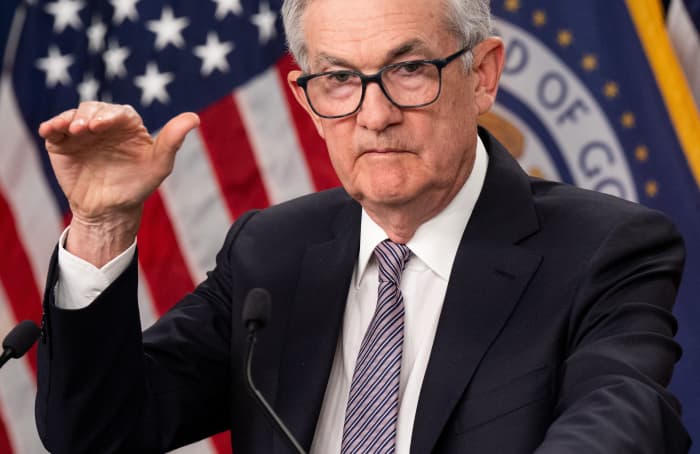Most of Federal Reserve Chair Jerome Powell’s messaging to markets on Wednesday may lean toward hawkish monetary policy, but that might not keep a lid on stock prices for very long after any potential pullback, according to BlackRock’s Rick Rieder.
“I think the stock market is anticipating he’s going to be hawkish on inflation,” said Rieder, BlackRock’s chief investment officer of global fixed income and head of the firm’s global allocation investment team, in a phone interview. He’s probably “going to continue to pound the table that inflation is their number one objective today.”
The Fed is widely expected to announce on Wednesday that it’s raising its benchmark interest rate by a quarter percentage point to a target range of 5.25% to 5.5%, in an effort to lower elevated inflation. Investors will be listening closely for how Powell speaks to the balance of risks involved in tightening the Fed’s monetary policy to rein in the rising cost of living in the U.S. to its 2% target, according to Rieder.
While many investors have long feared the Fed risks triggering a recession after embarking early last year on an aggressive interest-rate-hiking campaign, the U.S. economy has been so far resilient.
To Rieder’s thinking, “their policy has been restrictive enough for a while now.” He said that “once you got above 4%, you started to move towards a restrictive rate.”
The Fed has slowed its rate hikes this year after rapidly lifting them in 2022. Now investors will be focused on whether Powell thinks another rate hike this year may be needed after July, as well as the Fed Chair’s description of the pace of getting to another potential rate rise later in 2023, according to Rieder.
Powell may lean hawkish in indicating that a rate increase could be on the table at the Fed’s September meeting, said Rieder, whose base case is that, after the anticipated hike in July, the Fed may pause before potentially lifting rates again in November.
Meanwhile, the surge in the cost of living in the U.S. has been easing.
“The trend is clearly in favor of lower inflation,” but the question is whether it has come down enough to alter Powell’s perspective on continuing with further rate hikes, said Rieder. He raised concerns over pressure from rate increases on the banking system and commercial real estate, as well as the labor market.
The labor market has been “very strong” amid a structural lack of available workers for the jobs open to be filled in some areas, said Rieder, questioning why the central bank would want to weaken it when inflation is already coming down as past rate hikes work with a lag through the system.
Full employment is one of the Fed’s dual mandates, said Rieder, along with price stability in the economy. In his view, inflation, which had spiked because of a “massive supply shock” during the pandemic, may continue to come down if the Fed patiently waits for its past rate increases to “marinate through the system.”
Rieder will also be looking for any signs of “patience” from the Fed after Wednesday’s meeting concludes, as he worries the central bank’s rate increases have already reached a restrictive level.
Other market experts have expressed worry in recent months over the damage the Fed’s continued rate hikes could inflict on the economy.
For example, Edward Yardeni, president of Yardeni Research, told MarketWatch in May that “the last two rate hikes were nuts” after the Fed’s rate increase that month. And Campbell Harvey, director of research at Research Affiliates, said in a June interview with MarketWatch that the U.S. may be in “the lull before the storm” while expressing worry that the Fed’s continued rate hikes this year raised the odds of a “hard landing” for the economy.
While Powell probably will have “inflation as the bull’s-eye of where policy is going to go for the foreseeable future,” said Rieder, the stock market currently has a “tremendous” technical backdrop. He pointed to the trillions of dollars sitting in money market funds as many people have been bearish about equities even as the market has jumped this year amid stock buybacks and a light calendar for initial public offerings.
While Big Tech stocks have driven the S&P 500’s gains this year, Rieder says many equities are trading at “reasonable” valuations. He said airlines, autos, homebuilders and healthcare are among the areas of the stock market that he likes.
Investors have the opportunity to own high-quality assets in the bond market with very short durations to get some yield, while buying some equities for “upside,” according to Rieder. “That’s much more attractive than owning a lot of long maturity bonds,” he said.
The stock market could continue to “grind higher” from here barring some exogenous event, said Rieder, although, after a “pretty good run” in the past couple of weeks, equities could “back off a bit” for a day or so on Powell potentially sounding hawkish on inflation.
U.S. stocks closed higher on Tuesday, with the S&P 500
SPX,
Read: As tech stocks skyrocket, here are the S&P 500’s best and worst sectors for profit margins
In the bond market, the yield on the 10-year Treasury note
TMUBMUSD10Y,
Traders in the federal-funds-futures market on Wednesday morning were expecting the Fed to raise its benchmark rate by a quarter percentage point, with the central bank’s announcement on its policy decision scheduled to be released at 2 p.m. Eastern Time. Powell is expected to hold a press conference at 2:30 p.m.
Fed-funds futures were pointing to a roughly 79% chance of the Fed pausing its rate increases at its September meeting, potentially keeping them at the 5.25% to 5.5% level they’d reach after the anticipated July hike, according to the CME FedWatch Tool, at last check.







